737-215-3211

A Guide To Traveling With Large Breed Puppies
Visiting and traveling to a new place with your beloved pup is exciting. However, if you're not prepared, it can turn into a stressful disaster.
To ensure you're making unforgettable fun memories with your adorable large dogs with these essential tips, tricks, and advice. Whether you're traveling with your large dog by car or by plane, this guide will help make sure you have a smooth and safe travel with your furry friends!
Pre-Travel Essentials
Traveling with a large dog internationally or domestically will not be fun and comfortable without bringing all the essential documents, a pet carrier, dog treats, and other puppy essentials. Here's a list of dog travel essentials all pet owners must have:
-
Travel Crate or Pet Carrier: A secure and well-ventilated dog's crate or travel carrier is essential, especially if you're traveling by car or airplane. Dog crates and pet carriers provide a safe space for your large dog during the journey.
-
Poop Bags and Waste Disposal Supplies: Be responsible and clean up after your large dogs during rest stops or walks.
-
Travel Documents: Ensure you have all necessary documents, including vaccination records, health certificates, and any required permits for your destination.
-
Extra Dog Leash and Pet Collar: It's always a good idea to have backups in case of wear and tear or if one gets lost.

-
Identification Photos: Carry recent photos of your dog in case they get lost.
-
Towels and Cleaning Supplies: Accidents can happen, so it's wise to have towels, cleaning wipes, and stain removers on hand.
-
Travel Water Filter or Bottled Water: Some dogs can be sensitive to water changes, so having familiar water can prevent stomach upset. Also, bring dog water bottles so you can keep your big dogs hydrated throughout the travel.
-
Doggie Seat Cover or Protective Barrier: If traveling by car, seat covers like PetSafe Happy Ride Quilted Bench Seat Cover can help protect your vehicle's interior and keep your dog secure. Or place MIM Safe VarioBarrier in your car's compartment.
-
Travel Itinerary: Share your travel itinerary and plans with a friend or family member.
-
Comfort Items: Traveling with big dogs can be stressful. To ensure your large dogs are comfortable and keep your dog calm during the travel, bring their favorite dog toys, blankets, pillows, and pet beds.
Traveling With Large Dog By Car
When traveling with your big dog by car, it's essential to ensure their safety, comfort, and well-being throughout the journey. Here's a detailed breakdown of the key considerations:
Preparing the Car
Before hitting the road, prepare your vehicle to accommodate your large pup. This ensures your large dogs are safe and comfortable during the road trip. It also decreases your stress and worry while driving.
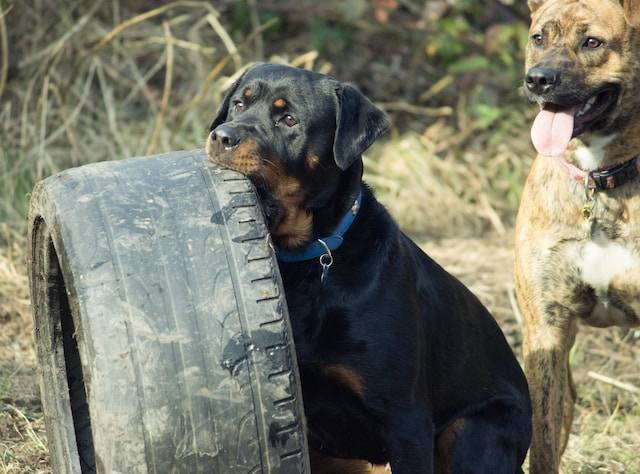
-
Safety Restraints and Barriers: Use specially designed dog seatbelts, harnesses, or car barriers, like MIM Safe VarioGate Double, to keep your large breed dog securely in place while the car is in motion. This prevents distractions to the driver and keeps your large dog safe.
-
Dog Seatbelts and Crates: Depending on your dog's size and temperament, consider using a large dog seatbelt harness or a dog's crate.
Frequent Stops
Make sure to plan for breaks along the way to attend to your puppy's needs.
-
Importance of Breaks: Large dogs need opportunities to stretch their legs, have a bathroom break, and get some exercise. Plan regular stops every few hours to allow your dog to move around and relieve themselves.
-
Planning Rest Areas: Research pet-friendly rest areas along your route ahead of time. Look for places with green spaces or designated pet areas for exercise and play.
Comfort and Safety
Create a comfortable and safe environment within your car for your large dog.
-
Adequate Space and Ventilation: Ensure your big dogs have enough space to lie down comfortably and turn around. Proper ventilation is crucial to keep the car well-ventilated and maintain a comfortable temperature.
-
Temperature Control: Be mindful of temperature extremes. Avoid leaving your big dog in a hot car, even for a few minutes. In colder weather, provide a warm blanket or bedding.
Feeding and Hydration
Properly manage your big dog's meals and water intake during the trip.
-
Timing Meals: Feeding your large dog a light meal a few hours before the trip can help prevent car sickness. Avoid feeding a heavy meal right before departure.
-
Provide Water: Offer small sips of water during rest stops to prevent dehydration, but be cautious not to overhydrate, which can lead to more frequent bathroom breaks. Use spill-proof travel water bowls like MIM Safe Spill-Proof Water Bowls For Variocage.
Flying With Larger Dogs
Traveling by air with your big dogs can be a convenient way to reach your destination, but it requires careful planning and consideration to ensure your puppy's safety and comfort. Here's a detailed breakdown of the key steps involved:
Choosing the Right Airline
Selecting the appropriate domestic and international flights is the first crucial step when flying with a large breed puppy.
-
Research Pet Policies and Fees: Before booking a flight, thoroughly research the pet policies of different commercial airlines. Pay attention to their pet fee, dog's weight limit, and specific requirements for flying large dogs to find an airline that best suits your needs and your puppy's size.
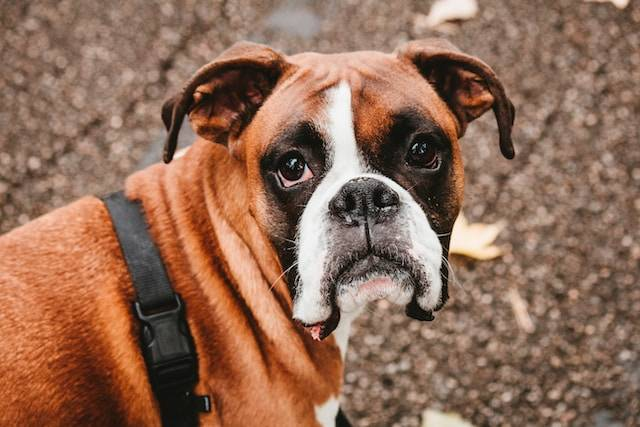
-
In-Cabin vs. Cargo Hold Options: Determine whether your large breed puppy can travel in the cabin with you or must be transported in the cargo hold. Most airlines allow small dogs in the cabin, while others require larger dogs to be transported as cargo. Choose the option that aligns with your puppy's size and the airline's regulations. If you're fly in cabin with your pets, many airlines require them to be deducted from your carry-on luggage weight limit. Also, if you have flat-face dogs, they cannot travel as checked baggage.
-
Check the Commercial Airlines' Safety Records: Look into the airline's safety record and reputation. Ensure they have a good track record of safely transporting animals or large dog flying, especially in the cargo hold if applicable. Safety and comfort should be your top priority.
-
Size and Type of Aircraft: Consider the size and type of aircraft used for your flight. Larger planes may have more spacious cargo holds, which can be more comfortable for your large dog if they need to travel as cargo.
-
Temperature Considerations: Be aware of the airline's policies regarding temperature restrictions for pet travel. A few commercial airlines may have restrictions on flying large service dogs or pets during extreme hot or cold weather to ensure their safety.
Booking the Flight
Once you've selected an airline for international or domestic flights, proceed with booking your flight with your larger dog in mind.
-
Selecting a Direct Flight When Possible: Whenever feasible, choose a direct flight to minimize the duration of travel for your puppy. Layovers and connecting flights can add stress and discomfort, so opt for the most direct route if available.
-
Notifying the Airline in Advance: Inform the airline in advance that you'll be flying with a large breed puppy. Most airlines often have specific procedures and requirements for flying with a large pet and notifying them beforehand allows you to prepare accordingly.
Security and Identification
Take precautions to ensure your puppy's security and identification throughout the domestic or international flight.

-
Securely Attach Identification to the Crate: Attach clear identification to the crate, including your contact information, flight details, and a photo of your furry friend. This helps airline personnel and authorities identify your large pets or emotional support animals in case of any issues.
-
Microchipping Your Pup: Consider microchipping your puppy as an extra layer of identification. Ensure the microchip is registered with your current contact information.
Arrival and Post-Flight Care
After the long domestic or international flights and upon arrival at your destination, focus on calming your puppy and monitoring their well-being.
-
Calming and Reassuring Your Puppy: Once you and your pup have safely arrived, take the time to comfort and reassure them. Provide familiar dog toys, water, and a cozy blanket to help them feel secure.
-
Monitoring for Any Signs of Stress or Discomfort: Keep a close eye on your large dog for any signs of stress or discomfort following the flight. If you notice any issues, consult with a veterinarian promptly to ensure your puppy's well-being.
Tips For A Smooth And Fun Journey
Here are some tips for a smooth and fun journey when traveling with your large breed puppy:
-
Plan Ahead: Careful planning is key to a successful trip. Research pet-friendly accommodations, activities, and restaurants at your destination, and make any necessary reservations in advance.
-
Practice Makes Perfect: Before the trip, take short practice drives or walks with your puppy to get them used to the travel routine and being in a new environment.
-
Safety First: Always prioritize your puppy's safety. Use appropriate safety restraints or airline-approved travel crates when traveling by car, and follow airline guidelines when flying.
-
Frequent Breaks: Plan regular breaks during car journeys to allow your puppy to stretch, exercise, and relieve themselves. Make these breaks enjoyable by exploring pet-friendly parks or rest areas.
-
Stay Calm and Positive: Dogs are perceptive and can pick up on your emotions. Stay calm and positive to help your puppy feel at ease during travel.
-
Training and Behavior: Basic obedience commands can be invaluable during travel. Ensure your puppy knows commands like "sit," "stay," and "come," which can help maintain control in unfamiliar environments.
-
Reward-Based Training: Use positive reinforcement techniques to reward good behavior. Dog treats like Omega Fields Smart Hearts Dog Treats, praise, and toys can be excellent motivators for your puppy.
-
Hydration and Nutrition: Provide access to water during breaks, but be mindful not to overfeed or overhydrate, which can lead to motion sickness or frequent bathroom stops.
-
Comfort Items: Bring familiar comfort items like their bed, favorite toy, or blanket to provide a sense of security and home during the journey.
-
Stay Organized: Keep all your pet's essentials, such as food, medication, and travel documents, organized and easily accessible. Place them inside the Mobile Dog Gear Patented Rolling Week Away Dog Travel Bag.
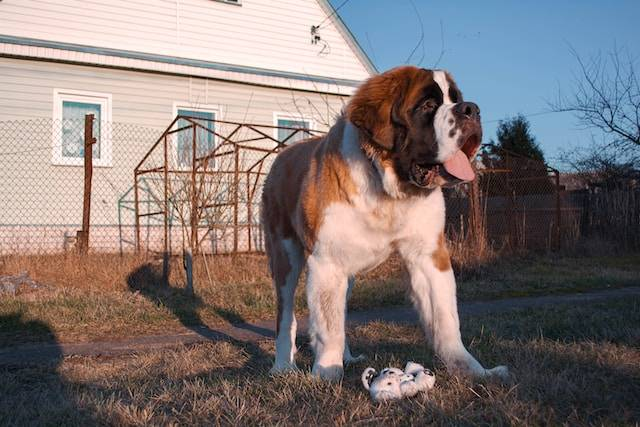
FAQs
How do I choose the right airline for flying with a large dog?
When choosing the right airline for flying with your large dog, consider several factors.
Firstly, check if the airline allows large dogs in-cabin or if they must travel in the cargo hold due to size. Secondly, research the airline's safety record for pet travel, ensuring a reliable and secure journey for your furry friend. Opt for direct flights when possible to minimize travel duration and stress. Review the airline's pet policies, including weight limits and fees, to avoid surprises.
Lastly, prioritize airlines that demonstrate a commitment to temperature control and overall pet safety, especially if your dog is flying in the cargo hold.
If I have service animals, can I fly with my service dogs inside the plane's cabin?
Yes, typically large service dogs fly inside the plane's cabin. Service animals or emotional support dogs, such as guide dogs or assistance dogs, are generally allowed to accompany their handlers in the cabin per the regulations outlined by the Air Carrier Access Act (ACAA) and the Americans with Disabilities Act (ADA).
However, there are certain requirements you must meet, such as providing advance notice to the airline about your service animal's presence and completing any necessary documentation. Your service dog should be well-trained and well-behaved to ensure a safe and comfortable flight for all passengers.
It's advisable to check with the airline in advance to understand their specific policies and any documentation they might require to accommodate your service animal.
What are the best ways to exercise my large dogs before a long journey?
Exercise your large dog before a long journey by engaging in activities like brisk walks, runs, or playtime in a secure area to burn off energy. Mental stimulation through puzzle toys or training exercises can also help tire them out.
Ensure not to overexert your dog and schedule exercise sessions ahead of your trip, allowing time for rest and recovery. This helps keep your dog calm and comfortable during the journey, contributing to a smoother travel experience for both of you.
How old does a puppy have to be to fly?
In general, whether you have a large or small dog, your pup should be at least 8 weeks old to fly on commercial airlines. Check with your airline and vet to make sure your pup is ready for flying.
Is it safe for dogs to fly in cargo?
Technically, yes, flying with a large dog is safe. However, certain precautions should be taken. Choose airlines with a good track record for pet safety, adhere to their guidelines, and use an appropriate travel crate. Ensure your dog is healthy and acclimated to the crate.
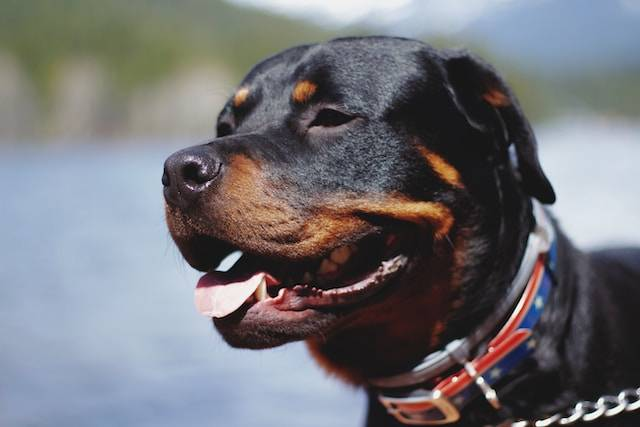
Travel In Style And Comfort With Puppy Fever Pro's Travel Pet Crates
Make new fun memories with your beloved large dog by traveling with them to visit new places by car or plane. Ensure they're comfortable and happy by being prepared, doing your research, and having the best dog travel essentials from Puppy Fever Pro.
We have many quality dog products for traveling or your pet's everyday needs. Check out our dog kennels, doors, grooming essentials, and more! And for more tips and tricks for dog lovers, go to our blogs.
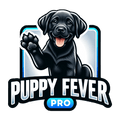

Leave a comment